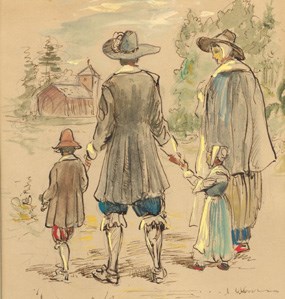
In one of his books, Captain John Smith wrote of building the first structure at Jamestown that was used as a church. According to his account, the settlers stretched a sail among the boughs and used rails to construct the sides of the structure. They sat on benches made of unhewed tree trunks. The altar was simply a log nailed to two neighboring trees. This was a purely temporary arrangement and is not counted as a church building. First Church -- In 1607, the settlers built the first real church inside the fort. Smith related that this was a barn-like structure, but he gave few details. The settlers worshipped in it until it was destroyed by fire in January 1608. Second Church -- The church which was built after the fire in 1608 was similar in appearance to the first church. When Lord De La Warr arrived as governor in 1610, he found that the church had fallen into a sad state of disrepair, so he had it restored and its furnishings improved. It is assumed that this is the church in which Ann Burras and John Laydon were married and their daughter, Virginia Laydon, was later baptized. When Captain Samuel Argall came to Jamestown in 1617, he found "but five or six houses, the church downe, the palizados (palisades) broken, the bridge in pieces, the well of fresh water spoiled, the storehouse used for the church; the marketplace, the streets and all other spare places planted with tobacco; the savages as frequent in their homes as themselves, whereby they were become expert in our armes...the Colonie dispersed all about planting Tobacco." Third Church -- In 1617, Captain Argall built a church. This is the first church known to have been built on the site where the present church stands. We know that this was constructed of timbers, but we do not know whether it was "wattle and daub" or a frame structure. The unusual feature of this church was its cobblestone foundation. This church is best remembered as the meeting place of the first Representative Legislative Assembly, which convened there on July 30, 1619. This church endured until 1639, when it was replaced by a brick structure. Fourth Church -- This brick church was begun in 1639, but took about five years to complete. During Bacon's Rebellion in 1676, this church was burned. The extent of the damages is unknown. The church was subsequently repaired. It continued to serve its congregation until approximately 1750, when it was abandoned in favor of a new church constructed some three miles from Jamestown. Following its abandonment, the ravages of time and the elements took their toll until it eventually fell into a complete state of ruin, with the exception of most of its tower, which still stands today. Fifth Church -- In 1907, the National Society of Colonial Dames of America erected a reconstruction church next to the original tower. This is the structure which visitors to Jamestown view today. The cobblestone foundations of the 1617 church, together with the brick foundations of the 1639 church, may be viewed under glass within the walls of the present church. |
Last updated: February 26, 2015
